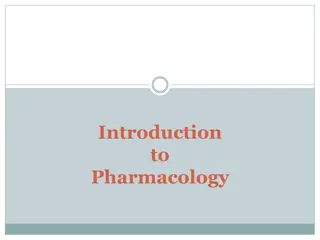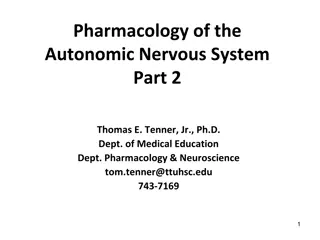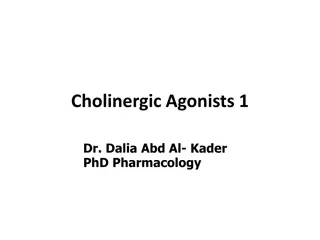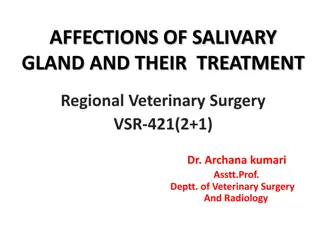Overview of Sedatives and Hypnotics in Veterinary Pharmacology
This chapter discusses the classification, salient features, and uses of sedatives and hypnotics in veterinary pharmacology. Sedatives subdue excitement and induce calmness without necessarily causing sleep, while hypnotics induce and maintain sleep. Both classes of drugs act as CNS depressants and are used for various purposes in veterinary medicine, including the treatment of insomnia. The distinction between sedatives and tranquilizers is also explored in this overview.
Download Presentation

Please find below an Image/Link to download the presentation.
The content on the website is provided AS IS for your information and personal use only. It may not be sold, licensed, or shared on other websites without obtaining consent from the author. Download presentation by click this link. If you encounter any issues during the download, it is possible that the publisher has removed the file from their server.
E N D
Presentation Transcript
Hypnotic - Sedative Dr.Kumari Anjana Assistant Professor Deptt. of Veterinary Pharmacology & Toxicology Bihar Veterinary College, Bihar Animal Sciences University, Patna
Overview of the chapter Introduction (Sedatives, Hypnotics). Salient features of Sedatives and Hypnotics. Classification of Hypnotic- Sedatives Barbiturates Benzodiazepines (advantages over barbiturates, MOA) Cloralhydrates Paraldehyde Methaqualone Glutithimide Xylazine hydrochloride Detomidine hydrochloride Medetomidine hydrochloride
Sedatives Sedatives: A drug that subdues excitement and calms the subject without inducing sleep, though drowsiness may be produced. Sedation refers to decreased responsiveness to any level of stimulation; is associated with some decrease in motor activity and ideation. On the basis of the type of effect produced by sedatives, it can be classified into two major groups: Hypnotic Sedative Tranquillizers- Sedative
Hypnotics: A drug that induces and/or maintains sleep, similar to normal arousable sleep. Hypnosis is derived from Hypnos , the Greek god of sleep. Effect produced by hypnotics hypnosis. These drugs produces drowsiness and facilitate the onset and maintenance of a state of sleep.
Hypnotic- Sedatives Salient features of Sedatives and Hypnotics: The Sedatives and Hypnotics are more or less general CNS depressants with some what differing time-action and dose action relationships. Those with quicker onset, shorter duration and steeper dose-response curves are preferred as hypnotics while more slowly acting drugs with flatter dose-response curves are employed as sedatives. However, there is considerable overlap; a hypnotic at lower dose may act as sedatives.
Thus, sedation-hypnosis-general anesthesia may be regarded as increasing grades of CNS depression. Both Sedatives and Hypnotics do not possess analgesic property, but dull the perception of pain sensation. Hypnotics given in high doses can produce general anesthesia. Hypnotics in higher doses cause deep sleep (narcosis) and hence are also called as narcotics. Treatment of insomnia is the most important use of this class of drugs.
The difference between sedatives and tranquillizers is also indistinct except that the tranquillizers produce a state of calmness with less drowsiness. Tranquillized animals are usually easy to handle, but they may be aroused by and respond to stimuli in a normal way (biting, scratching and kicking). In veterinary medicine Sedatives are generally used to restrain, to facilitate handling and transport, and to modify behavior of animals. Sedatives are commonly included in pre- anesthetic medication and are also used to facilitate minor surgery or diagnostic procedures.
Dose response curve of sedative and hypnotics Drug A Barbiturates Steeper DRC Narrow margin of safety Drug B Benzodiazepines Flatter DRC Wide margin of safety
Classification of Hypnotic- Sedatives Barbiturates Benzodiazepines Miscellaneous agents Barbitone, Phenobarbione, Pentobarbitone, Amobarbitone, Secobarbitone. Long acting Benzodiazepines: Diazepam, Flurazepam, nitrazipam and flunitrazepam. Short acting Benzodiazepines: Midazolam, triazolam, timazepam, lorazepam, oxazepam. Cloralhydrates Paraldehyde Methaqualone Glutithimide Xylazine hydrochloride Detomidine hydrochloride Medetomidine hydrochloride
Barbiturates Derivative of barbituric acid (A condensation product of urea and malonic acid). Classification of barbiturates based on duration of action: Long acting-(4-6 hr) - Barbitone, Phenobarbitone, methylphenobarbitone, aprobarbitone Intermediate acting (2-4 hr) - Pentobarbitone, Butobarbitone Short acting (1-2 hr) - Secobarbitone, Pentobarbitone, quinalbarbitone Ultra Short acting (20-40 min.) - Thiopentone, Thiamylal, hexobarbitone, methylhexitone
MOA of barbiturates: potentiate GABAergic inhibition. The long, medium and short acting barbiturates are generally used as hypnotics and sedative. Barbitone, Phenobarbione, methylphenobarbione, butobarbitone, Pentobarbitone and Amobarbitone are the most commonly used barbiturates. All barbiturates have reversible depressant effect on the activity of all excitable cells, the CNS being more sensitive. At hypnotic doses, it produce very little effects on cardiac smooth or skeletal muscle. Long acting barbiturates are better inducer of hepato-microsomal enzymes in comparison to short acting barbiturates .
Benzodiazepines Benzodiazepines are commonly used as sedatives or hypnotics in man and dog. These compounds have several advantages over barbiturates as hypnotic and sedatives. --- o Benzodiazepines have high therapeutic index. Ingestion of even 20 hypnotic doses does not usually endanger life there is no loss of consciousness. o Hypnotic doses do not affect respiration or cardiovascular function. o BZDs have practically no action on other body systems. Only on i.v. injection the BP falls and cardiac contractibility decreases. o BZDs do not alter disposition of other drugs by microsomal enzyme induction. o Their toxicity (due to higher dosage) can be overcome by giving specific benzodiazepine receptor antagonist flumazenil.
Classification of Benzodiazepines Hypnotic- Diazepam, nitrazipam flunitrazepam Anxiolytics:- Diazepam, Chlordiazepoxide, Oxazepam Lorazepam. Anticonvulsants-Diazepam, Clonazepam Flurazepam,
Mechanism of Action of Benzodiazepines Fig: GABAA Benzodiazepines receptor-Cl- channel complex Source: Book : Essentials of Medical Pharmacology
Benzodiazepines preferentially act on mid brain ascending reticular formation (maintains sleep-wakefulness cycle) and on limbic system (thought and mental functions). Their mechanism of action is through enhancing presynaptic or postsynaptic inhibition of specific benzodiazepine receptor which is an integral part of GABAA receptor-Cl- channel complex. The subunit of this complex form a pentameric transmembrane anion channel gated by the primary ligand (GABA), and modulated by secondary ligands BZDs.
Only the and subunits are required for GABA action, and most likely the binding site for GABA is located on the subunits, while the / subunit interface carries the BZDs binding site. The modulatory BZD receptor increases the frequency of CI- channel opening induced by submaximal concentrations of GABA. The BZDs also enhance binding of GABA to GABAA receptor. It is noteworthy that, the BZDs do not themselves increase CI- conductance, these exert only GABA facilitation, but not GABA mimetic action. GABA modulates activation of Cl-channels within the neuronal membrane of excitable neurons.
Pharmacokinetics: Oral absorption of benzodiazepines differs due to their variation in lipid solubility. These drugs due to lipid solubility gain access into CNS. Benzodiazepines are metabolized in liver through Most of the benzodiazepine drugs have active metabolites (glucuronide conjugates) are excreted through urine. Most of the benzodiazepine drugs have active metabolites (chlordiazepoxide, desmethyldiazepam, diazepam, flurazepam etc.) which undergo enterohepatic recycling (have long half-lives). Chlorazepine is metabolically activated to desmethyldiazepine, which is further metabolically activated to oxazepam.
Miscellaneous agents Chloral hydrates: It is one of the oldest and most important drug for induction ofsedation in large animals. For sedation it is administered IV or oral route, however, IV route is preferred. Horse: It is used to quiten the animals for shoeing or other procedures and it is also used in treatment of colic. Horses: 22.5-30 g /450kg by IV route. 60g /450kg by stomach tube. Cattle: 10.5- 17.5 g /450kg by IV route 15- 45 g /450kg by oral route. Sheep and Pigs: 2-4 g by oral route. Camel: 100mg/kg by IV route.
Xylazine hydrochloride Xylazine is classified as an analgesic as well as a sedative and skeletal muscle relaxant. It is not a neuroleptic or tranquillizer nor an anaesthetic agent. Xylazine is a potent a2-adrenergic agonist. Through its central stimulation of a2-adrenergic receptors, xylazine has potent antinociceptive or analgesic activity. It is most suitable sedative for use in ruminants. In cattle, doses that produce deep sedation and analgesia are 1/10th those required in horses, dogs and cats. It is not effective in swine.
Doses: Dog & cat : 1.1 mg/kg I.V. route ; 2.2 mg/kg I.M. or SC route. Horse: 1.1 mg/kg I.V. route ; 2.2 mg/kg I.M. or route. Cattle: 0.1 0.35 mg/kg I.M. route. Goat: 0.1 mg/kg I.V. or route.
Detomidine hdrochloride: It is selective a2-adrenergic agonist, developed as sedative and analgesic for use in animals. It produces biphasic response on BP, (initial rise in BP but subsequently, BP falls). It is effective in very low concentration. Cattle and Horse: 10-30 g/kg I.V. route. Goat: 10-40 g/kg I.V. or route. Sheep : 30 g/kg I.V. or route. Medetomidine hydrochloride: It is also selective a2-adrenergic agonist. It is a mixture of two optical isomers, the dextrorotatory isomer being the active components. It is used in animals as a sedative hypnotic analgesic and as pre-anesthetic medication.
Uses : As chemical restraints. To induce sleep. As preanaesthetics.

















































